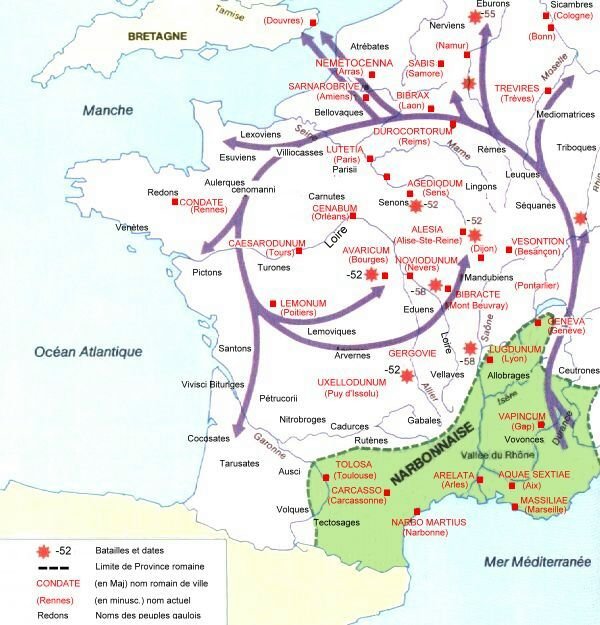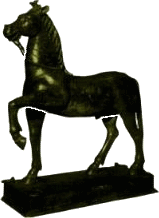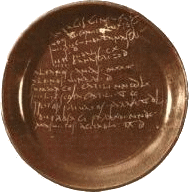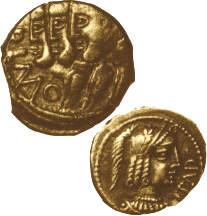To-day, I'll begin to count for you the History of my country : The Loire Valley...
I
CROSSROADS OF DESTINY
Some places are privileged to be the sites of events that could have occurred nowhere else. And even if the same events had occurred elsewhere, they would very likely have had very different consequences. But the times, technology, customs or concerns of the moment caused certain events to happen in these places rather than others. Is that, perhaps, what we mean by destiny?
Paths cross and then overlap. For thousands of years, climatic variations, tribal rivalries and cultural friction changed nothing: one after the other, waves of immigrants came by the same roads to the same places of worship or settlement. Topography and the strategic location of these places predestined them from the dawn of time to play their parts in history.

Since rivers are natural highways, the Loire has always been traveled by both merchants and armies on the move. The river's banks and hills have always been inhabited, and cities arose on its shores at the crossroads of highways. Cenabum (Orléans) and Caesarodunum (Tours) were there when Caesar invaded Gaul in 58 B.C.
The inhabitants of the area were known as the "Carnutes". Their territory stretched from the Seine to the Loire and included the regions of Chartres and Orléans. Farther downstream, the "Turones" lived in what would become the Touraine. To the south lived the "Bituriges" whose capital city, Avaricum, was considered the center of the Celtic world. (v.§ Berry) Upstream lived the "Arvernes", (v.§ Auvergne) whose famous chief "Vercingetorix" would led the federation of Gallic nations in their resistance to Caesar's armies. North of Tours were the "Aulerques" (v.§ Maine) and the "Andes" (v.§ Anjou); to the south, the Pictones (v.§ Poitou).
All these peoples were of Celtic stock and culture, and their Druids held ceremonies in many places to worship what we know as "the black Virgin," a universal symbol of the Earth Mother and of fertility.
In the Carnutes' country, Autricum, which would become Chartres, harbored a place of worship famous throughout all of ancient Gaul.
Saint-Benoît-sur-Loire (although it was not yet called that) was equally well known, and by long tradition the Celts made that site The place where Druids assembled every year in the country of the Carnutes.
The Gauls were far from being savages living in A part of a gallo-roman treasure discovered in the Orleans area wooden huts.

They were fierce warriors when they had to be, but they were also artisans accomplished in working stone, brick, metal (for arms or jewelry) and wood (carts, houses, boxes, etc.). They also excelled in construction, boat-building, fishing, ceramics, cattle raising, etc., and in agriculture.
Their Druids were learned in various specialties. The most advanced among them were knowledgeable in herbal medicine, astronomy, music and mathematics. They had a common Gallic language, although it was a kaleidoscope of regional dialects. Some were able to write, and merchants kept their accounts mostly in Greek numerals.

A popular comic strip of our times has probably helped give the Gauls a reputation for being contentious. And yet, Specimen of the gallic scripturewithout going so far as to say that they all lived in perfect harmony, the various Gallic nations lived peacefully enough to trade not only among themselves but with the rest of the known world, especially with the British isles and the Danube valley as well as with the peoples living on the Mediterranean and in the Near East. They traded especially with Roman colonies whose numerous markets were established in the main cities of Gaul.
The region of immense plains that some centuries later would be called the Beauce was extremely fertile. Both Cenabum and Autricum had granaries and feed reserves inside their fortifications. As fate would have it, this wealth would bring trouble.
Although the conquest of Gaul has been related to us by Caesar himself in his memoirs, let us try to erase the conqueror's viewpoint and try to understand that of the conquered. On the pretext that the Gallic nations' endless disputes threatened trade in the Roman colonies, Caesar sent a few legions to Gaul to "protect the interests of Rome." In the winter of 57-56 B.C. he assembled his legions in the region of the Carnutes, Andes and Turones. The purpose was very likely to make it easy to supply them with wheat and with forage for their animals.
When the neighboring peoples refused to give him supplies, Caesar had a fleet of galleys built on the Loire in order to defeat the main center of resistance, the Venetans, in Morbihan. The Venetans were expert sailors under the command of a certain "Decimus Brutus" (the name is authentic, but it wasn't the village of Astérix!). History does not tell us whether Caesar "brutally decimated" him, but he certainly defeated him because the next year, in 56-55 B.C., Caesar's legions wintered among the Aulerques and their neighbors the Lexones of Lisieux. It would seem that at that time most of Gaul was occupied by Roman legions and that colonization was already underway, which did not sit well with the natives. Resistance was in the air. And among the least docile were the Carnutes. But let us be patient.
In 53-52 B.C., Caesar moved his army into winter quarters and then went to Rome on leave. Six legions were camped among the Senons and were supposed to keep an eye on their obstreperous neighbors, the Carnutes.
The Gallic chiefs took advantage of Caesar's absence to prepare for war. The Carnutes took a solemn oath to fight to the death and sent a signal to Cenabum (Orléans) to massacre all Roman citizens as a symbol of resistance to foreign occupation.
The news of the insurrection was transmitted by voice from one field to another, by signals mounted on platforms and a network of artificial "buttes." The news reached the Arvernes that very evening at a distance of more than 250 km. Vercingetorix quickly rallied the Senons, Parisii, Pictons, Cadurques, Turons, Aulerques, Lenovices, Andes and the Gauls living along the Atlantic coast.
The uprising spread, and Vercingetorix won a series of victories, the most famous of which was at Gergovie. A systematic scorched-earth strategy soon reduced the Roman legions to a sorry state. But the Bituriges of Bourges begged the Gallic chief to spare their city and wealth. To his misfortune, he yielded to their plea. The tide turned against the Gauls' campaign because of this generous but regrettable weakness. The Roman legions had no scruples about taking the provisions that had practically been handed to them on a silver platter. Caesar rushed back from Rome. The legions were heartened by his return and, their strength restored by the pillage of Bourges, they pursued the Gallic army and surrounded it at Alesia.
Caesar was in charge again, and the master of military strategy overcame Gallic resistance once and for all. Vercingetorix cast down his arms at the feet of the Roman imperator. He was taken prisoner to Rome, walking behind a horse to which he was tied.
It is said that the war took the lives of a million Gallic warriors and that another million were taken as slaves. (Ceasar gave a Gallic slave Some gallic coins to each of his legionnaires). Of the Gallic peoples, only old men, women and children remained (a population that some authors estimate at between 12 and 23 million). Rome, ever ruthless, demanded from them a tribute of 40 million sesterces.

Gaul was completely subjugated by the month of February 52 B.C.
A month later, Caesar returned to Cenabum to take reprisals. He sacked and burned the town. The first fortifications of Orléans probably date from this time. They were built on the rectangular model of Roman encampments, and traces of them can still be seen today on map of the city*.
Gaul had become part of the ... PAX ROMANA...
To be continued...
Very interesting
Congratulations @secret-history! You received a personal award!
You can view your badges on your Steem Board and compare to others on the Steem Ranking
Do not miss the last post from @steemitboard:
Vote for @Steemitboard as a witness to get one more award and increased upvotes!